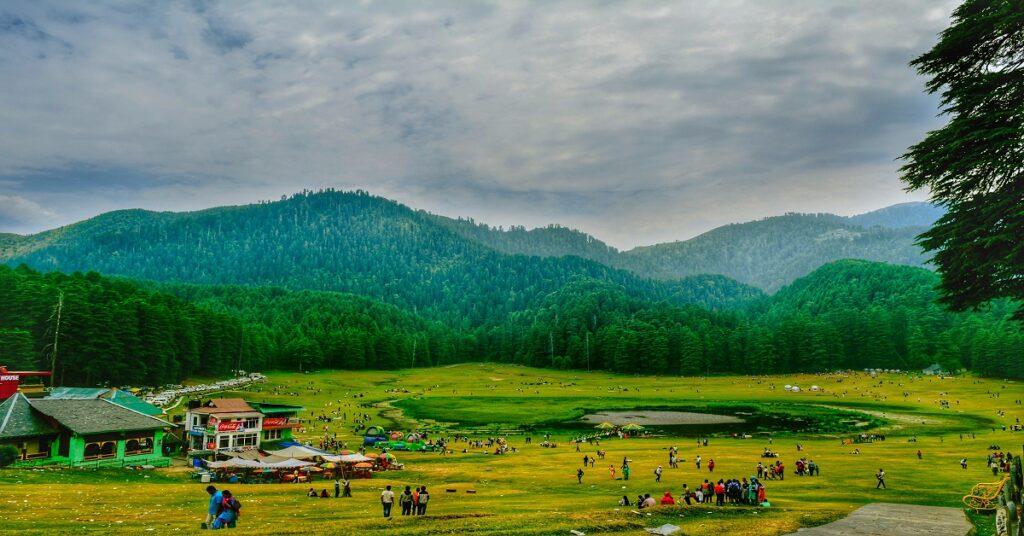Khajjiar, India: The Mini Switzerland of Himachal Pradesh

Nestled amidst the pristine forests of the Himalayas in the picturesque state of Himachal Pradesh lies the enchanting hill station of Khajjiar, often hailed as the “Mini Switzerland of India” for its striking resemblance to the landscapes of Switzerland. Situated at an altitude of 1,920 meters above sea level, Khajjiar captivates visitors with its lush green meadows, dense pine forests, and panoramic views of snow-capped peaks. Renowned for its natural beauty, serene ambiance, and adventurous activities, Khajjiar offers a tranquil retreat for travelers seeking respite from the hustle and bustle of city life.
Geographical Marvel: Khajjiar is nestled in the foothills of the Dhauladhar mountain range of the Himalayas, offering breathtaking vistas of the surrounding valleys and peaks. The town is renowned for its unique topography, characterized by vast expanses of green meadows interspersed with dense deodar forests, creating a landscape reminiscent of a fairytale paradise.
At the heart of Khajjiar lies a vast green plateau, often referred to as the “Mini Switzerland” for its striking resemblance to the landscapes of Switzerland. This idyllic setting, surrounded by towering trees and snow-capped mountains, serves as a perfect spot for picnics, leisurely walks, and photography enthusiasts.
Natural Attractions: Khajjiar is home to several natural attractions that draw visitors from far and wide. The Khajjiar Lake, located in the center of the meadow, is a serene body of water surrounded by lush greenery, offering a tranquil setting for boating and picnics. The lake is believed to be fed by underground springs and is considered sacred by the locals.
Adjacent to the lake lies the Khajji Nag Temple, dedicated to the serpent god Nag Devta. The temple is revered by the locals and attracts devotees who come to seek blessings and offer prayers amidst the serene surroundings.
Another popular attraction in Khajjiar is the Kalatop Wildlife Sanctuary, which encompasses a diverse range of flora and fauna. Visitors can embark on nature walks, birdwatching expeditions, and wildlife safaris to explore the sanctuary’s pristine forests and spot elusive species such as the Himalayan black bear, leopard, and musk deer.
Adventure Activities: Khajjiar is a paradise for adventure enthusiasts, offering a wide range of activities to suit every thrill-seeker’s appetite. Trekking is a popular activity, with numerous trails crisscrossing the surrounding hills and forests. The trek to Dainkund Peak, the highest point in the area, offers stunning views of the surrounding valleys and is a favorite among trekkers.
For those seeking an adrenaline rush, paragliding is a must-do activity in Khajjiar. The town’s favorable wind conditions and breathtaking landscapes make it an ideal destination for paragliding enthusiasts, who can soar high above the meadows and valleys while enjoying panoramic views of the Himalayas.
Other adventure activities available in Khajjiar include zorbing, horse riding, and mountain biking, providing endless opportunities for outdoor fun and excitement.
Cultural Heritage: Khajjiar is steeped in rich cultural heritage and folklore, with legends and myths woven into the fabric of its history. According to local folklore, Khajjiar derives its name from Khajji Nag, a mythical serpent deity worshipped by the people of the region. The Khajji Nag Temple, dedicated to the serpent god, is believed to have been built in the 12th century and is a testament to the town’s ancient roots.
The Gaddi tribes, who are the indigenous inhabitants of the region, have a rich cultural heritage and traditional way of life. Visitors to Khajjiar can interact with the Gaddi people, learn about their customs and traditions, and purchase authentic handicrafts and artifacts crafted by local artisans.
Preserving the Environment: As a popular tourist destination, Khajjiar is committed to promoting responsible tourism practices and preserving its pristine environment. Efforts are underway to minimize the ecological footprint of tourism activities and protect the region’s fragile ecosystems.
The local community is actively involved in conservation initiatives, such as tree plantation drives, waste management programs, and wildlife conservation efforts. Sustainable tourism practices, such as eco-friendly accommodations and nature-based activities, are encouraged to ensure that Khajjiar’s natural beauty remains intact for future generations to enjoy.
Conclusion: Khajjiar, with its breathtaking landscapes, adventurous activities, and rich cultural heritage, is a hidden gem nestled in the lap of the Himalayas. As visitors explore its verdant meadows, dense forests, and serene lakes, they are transported to a world of natural beauty and tranquility.
Amidst the majestic mountains and pristine valleys of Khajjiar, one finds a sanctuary of serenity and wonder, where the rhythms of nature and the spirit of adventure converge in perfect harmony. As we celebrate the splendor of Khajjiar and its status as the “Mini Switzerland of India,” let us also pledge to preserve and protect this precious gem for generations to come, ensuring that its beauty remains eternal for all to enjoy.




